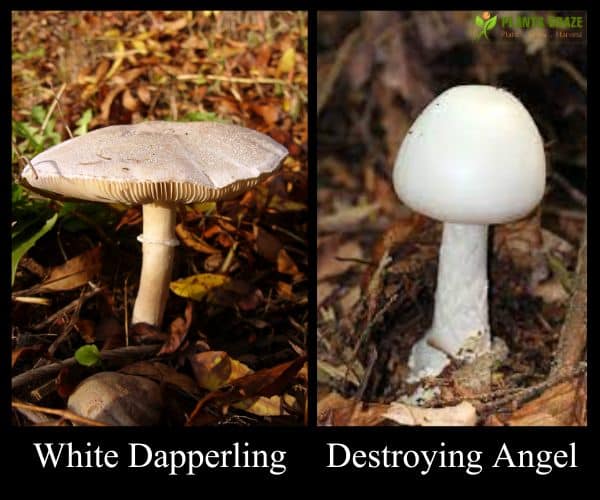Knowing White Dapperling vs. Destroying Angel can save you from going through fatal conditions, as one is edible and another can be deadly poisonous.
You can find both mushrooms growing from summer to fall, but Destroying Angel usually chooses to grow near the Birch trees.
So, go through this article to know the potential differences between similar Amanita Mushrooms, White Dapperling, and Destroying Angel to avoid the toxic traits.
Table of Contents Show
White Dapperling & Destroying Angel: Similarities
Both White Dapperling and Destroying Angel belong to a similar class Basidiomycetes and share the same genus Amanita.

Moreover, both mushrooms have white caps and white stems, making them resemble each other.
- Both mushrooms have gills on the stem’s underside. Gills look like an open book in both species.
- The stem is slender, and the cap looks like an open umbrella in both Mushrooms.
- Moreover, the cap is smooth, silky, and shiny in both White Dapperling and Destroying Angel.
- On the top of the stem, you can see a ring or annulus in both Mushroom varieties.
- Both Mushrooms have a mutual relationship with the roots of the Pine trees where they grow.
- You can find them growing in forests, meadows, and woodlands.
- Both mushrooms are wild, and people do not cultivate them due to toxicity risks.
White Dapperling Vs. Destroying Angel: Differences
Although White Dapperling and Destroying Angel bear similar genera, Destroying Angel is larger in size than White Dapperling.
Moreover, you can notice a pinkish hue on the cap of White Dapperling. Meanwhile, Destroying Angel bears a pure white cap without any tints.
| Features | White Dapperling | Destroying Angel |
|---|---|---|
| Cap | Size: 1-3 inches in diameter Color: Pale or cream colored with pinkish hue Shape: Flatter than Destroying Angel | Size: About 5 inches in diameter Color: Pale or pure white color Shape: Egg-shaped |
| Stem | Slender and cylindrical, 1.5-4 inches tall | Thicker than White Dapperling, up to 8 inches tall |
| Ring | Very gloomy ring | Dense ring with skirt-like annulus |
| Gills | Connected to stem | Free from stem |
| Spore Print | Pink | White |
| Volva | Absent | Present |
White Dapperling Mushroom is active in Europe, Asia, and North America, whereas Destroying Angel belongs to Europe and Asia.
Moreover, White Dapperling gets its food and grows on the dead and decayed items. In contrast, Destroying Angel has a mycorrhizal association with the trees it grows under.
Like most Amanita Mushrooms such as Death Cap, Destroying Angel bears the toxic compound Amatoxin which causes poisonous effects resulting in death.
From Editorial Team
White Dapperling Vs Destroying Angel: Toxicity Differences!
Interestingly, White Dapperling Mushroom is edible despite being a member of the Amanita genus. In contrast, Destroying Angel is highly poisonous and can cause serious stomach upset and organ failure.
However, it’s wise not to eat any wild mushrooms, as curiosity is not worth your life. Moreover, only buy the mushrooms from reputed stores to minimize the risks.


